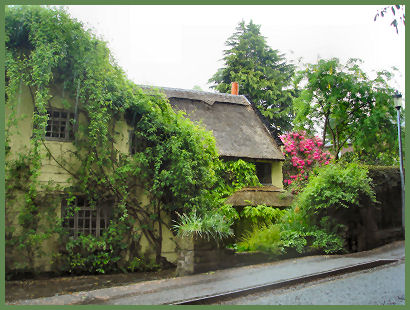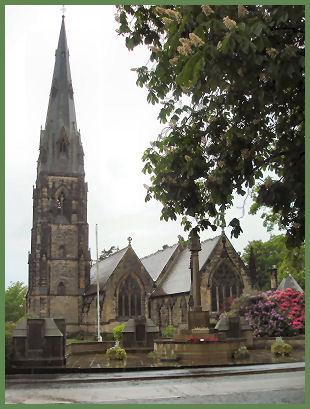Alderley Edge
OS Grid ref:- SJ 841 786
 Alderley Edge village lies around eight kilometres to the northwest of Macclesfield and 20 kilometres south of Manchester.
Alderley Edge village lies around eight kilometres to the northwest of Macclesfield and 20 kilometres south of Manchester.
The village nestles at the bottom of the Alderley Edge sandstone escarpment. The wooded escarpment is designated an Site of Special Scientific Interest due to its geology. Alderley Edge escarpment has been a site of copper mining for many centuries. The Alderley Edge Mines consist of an extensive series of workings with a number of entrances.
First written record of the village, then known as 'Chorlegh' appears in a thirteenth century document, the name derived from from ceorl and leah, which means peasants' clearing. The Chorlegh estates belonged to the aristocratic Fitton family in the thirteenth century and later passed to the Venables in the early fourteenth century. In 1403 Richard de Venable drowned in the River Bollin and the estates were passed down to his sisters, Alice and Dulcea. Sir Edward Trafford de Trafford married Alice when she was aged just 11, in 1409, by which means the estates passed to him, a common practice amongst aristocratic families in medieval times. The de Traffords held the estates until they passed to the Davenports in the sixteenth century. The land was eventually sold to Sir Thomas Stanley in 1640.
 The name 'Alderley' first appears in the Domesday Book of 1086, in which it is referred to as 'Aldredelie'. Several versions of the origin are known, one says it originated from 'Aldred 'and 'leah' meaning 'Aldred's Clearing'. Another says it is most likely that the name Alderley came from Old English language 'Alr?eleah' meaning "the meadow or woodland clearing of a woman called 'Alr?'.
The name 'Alderley' first appears in the Domesday Book of 1086, in which it is referred to as 'Aldredelie'. Several versions of the origin are known, one says it originated from 'Aldred 'and 'leah' meaning 'Aldred's Clearing'. Another says it is most likely that the name Alderley came from Old English language 'Alr?eleah' meaning "the meadow or woodland clearing of a woman called 'Alr?'.
The advent of the railway in 1842 brought prosperity and expansion to the village. The Manchester and Birmingham Railway Company built the line through the then vilage of Chorley. The village's name was changed in 1880 to avoid confusion with Chorley in Lancashire.
St Philip's Church (pictured right) with its towering 175 feet spire dates from 1853. In the south aisle is a stained glass window made by Morris & Co. and dating from 1873. In front of the church is the War Memorial, the slender pillar is topped by the figure of a soldier in a sentry post.
Known as the Champagne capital of Britain, Alderley Edge is justly famous for its affluence and expensive houses. It has many expensive designer shops and cafe/restaurants, numerous footballers, actors and multi-millionaires have made the village their home. The main street boasts a host of shops, pubs, cafes and restaurants. The village centre also has a large atractive park.
In the streets behind the main street is the Festival Hall. Alderley Edge has held an annual musical festival since 1911. The festival is generally held in May.
Famous past residents include the code breaker and computer pioneer, Alan Turing and the author Alan Garner, who grew up at Alderley Edge and later wrote the books 'The Weirdstone of Brisingamen', which was inspired by the legends which surround the Edge and 'The Moon of Gomrath'. Garner claimed that his great-great grandfather Robert Garner, a stonemason of Alderley Edge, created the Druid's Circle folly and the Magician's Well carving at the Edge.
Nearby Chorley Hall, which dates from the fourteenth century, is the oldest inhabited country house in Cheshire. The hall, a grade I listed building, is approached by a narrow stone bridge which crosses a moat. It was built by Robert de Chorley, a yeoman farmer, in around 1330. It has since been owned by the Davenport and Stanley families. The house was fully restored in 1915.
The Stanley Family of Alderley
Nearby places of interest
Alderley Edge escarpment- wooded Alderley Edge escarpment, wreathed in legend, is owned by the National Trust.
Alderley Edge Mines- extensive series of mines, mining first took place there in the Bronze Age and in Roman times.
Nether Alderley Mill- sandstone mill dating back to the fifteenth century.
Hare Hill Gardens- Hare Hill Garden is partcularly attractive in the early summer, the garden, which is set in 10 acres, contains more than 70 varieties of rhododendrons, plus azaleas hostas and a of national repute. At its heart is a delightful walled area with a pergola and wire sculptures.
